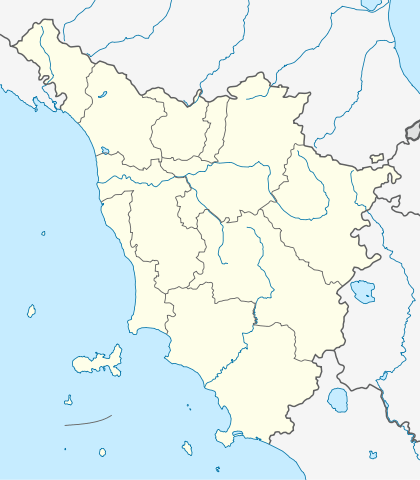Aulla
Aulla is a comune in the province of Massa and Carrara, Tuscany, central Italy. It is located in the valley of the River Magra.
Aulla | |
|---|---|
| Comune di Aulla | |
Panorama of Aulla | |
 Coat of arms | |
Location of Aulla 
| |
 Aulla Location of Aulla in Italy  Aulla Aulla (Tuscany) | |
| Coordinates: 44°13′N 09°58′E | |
| Country | Italy |
| Region | Tuscany |
| Province | Massa and Carrara |
| Government | |
| • Mayor | Roberto Valettini |
| Area | |
| • Total | 5,999 km2 (2,316 sq mi) |
| Elevation | 64 m (210 ft) |
| Population (30 June 2017)[2] | |
| • Total | 11,065 |
| • Density | 1.8/km2 (4.8/sq mi) |
| Demonym(s) | Aullesi |
| Time zone | UTC+1 (CET) |
| • Summer (DST) | UTC+2 (CEST) |
| Postal code | 54011 |
| Dialing code | 0187 |
| Patron saint | St. Caprasius |
| Website | Official website |
History
Traces of Roman and Etruscan civilizations found in the church of the Abbey of San Caprasio indicate that there were settlements in Aulla long before the 8th century CE, when margrave Adalbert I of Tuscany founded a village and built a castle to accommodate pilgrims traveling the via Francigena.[3] Here, at Aguilla Sigeric, Archbishop of Canterbury, sojourned on his return journey from Rome about 990.[4] The Malaspina family wrested feudal power of the city and its contada from the domination of the bishops and dukes of Luni. In 1543 the Centurione family purchased it. They built the Brunella Fortress, which was bought in the early 20th century by Aubrey and Lina Waterfield, and remains privately owned, functioning as a museum of natural history for the Lunigiana region. One of the most important buildings of the town is the Abbey of San Caprasio that was founded in the 9th century and named after Saint Caprasius of Lérins, whose body was transferred to Aulla in the 10th century.
In 1943 the historic center of Aulla was destroyed by Anglo-American bombings aimed at German troops stationed there during the Second World War. By the end of the war large sections of the city were obliterated by Anglo-American bombings which sought to destroy the town's key railroad network and gunpower manufacturing plant. A replica of an unexploded bomb is preserved in the former abbey of San Caprasio, which is now a museum.
In April 1945 the 442nd Infantry Regiment (United States), aided by a significantly strong Italian partisan fighting force, liberated the city of Aulla, after fierce battles with retreating German troops.
On 8 April 2020, a 260 metre long road bridge at Albiano Magra near Aulla collapsed into the River Magra. The traffic on the bridge was unusually light due to the coronavirus lockdown then in force, and the collapse resulted in only minor injuries to two casualties.[5][6]
Twin towns

References
- "Superficie di Comuni Province e Regioni italiane al 9 ottobre 2011". Istat. Retrieved 16 March 2019.
- "Popolazione Residente al 1° Gennaio 2018". Istat. Retrieved 16 March 2019.
- Geo Pistarino, Una fonte medievale falsa e il suo presunto autore (University of Genoa, 1958) demonstrated in detail that the notorious "cartulary of Aulla", supposedly drawn up at the end of the thirteenth century, was in fact a forgery by Alfonso Ceccarelli, who was executed for other forgeries in 1583.
- F. P. Magoun, Jr., "The Italian Itinerary of Philip II (Philippe-Auguste) in the Year 1191" Speculum 17.3 (July 1942;367-376) p. 373. Magoun notes that Philip Augustus of France may have stopped here on his more leisurely northward journey in 1191, but the possibly corresponding entry in his itinerary is unclear.
- "Lockdown keeps casualty figure low as Italian bridge collapses". The Guardian. London. 8 April 2020. Retrieved 9 April 2020.
- "Bridge Collapses in Italy, Newest Crumbling Infrastructure". The New York Times. 8 April 2020. Retrieved 9 April 2020.
External links
| Wikimedia Commons has media related to Aulla. |
